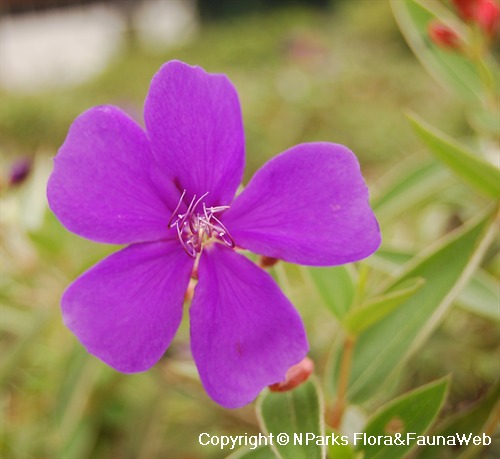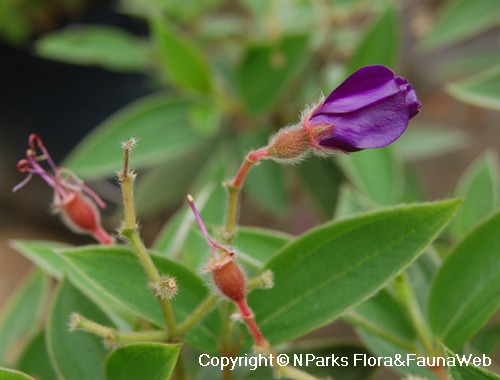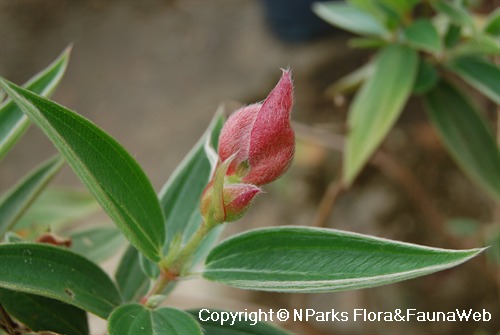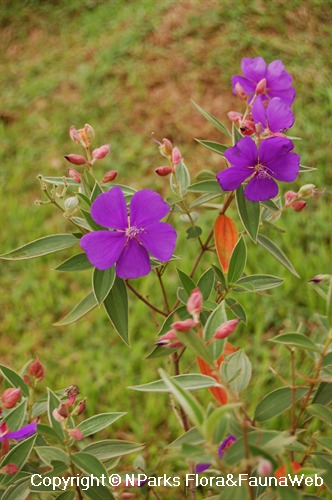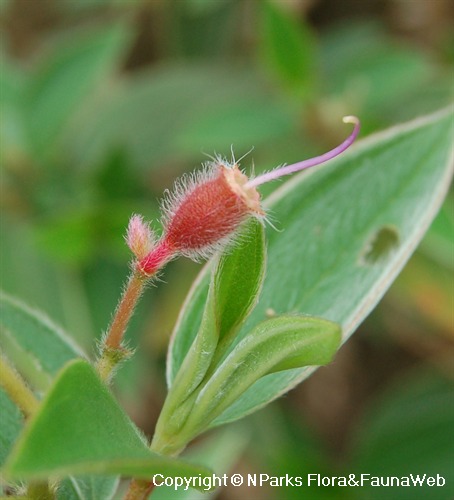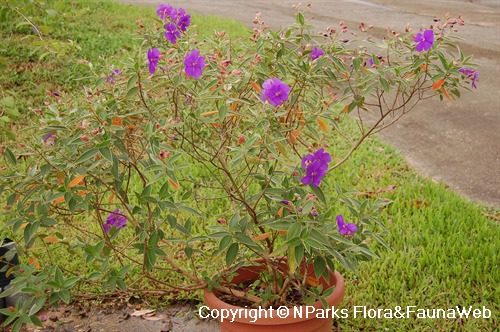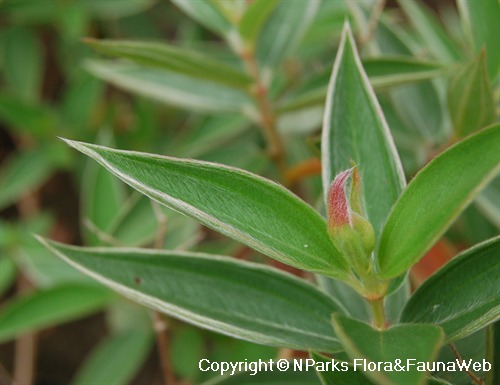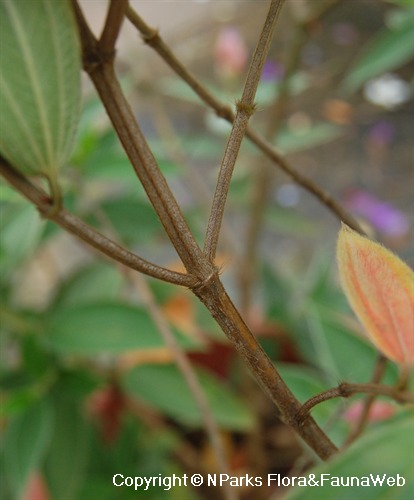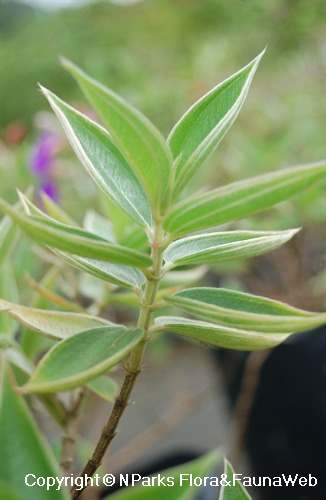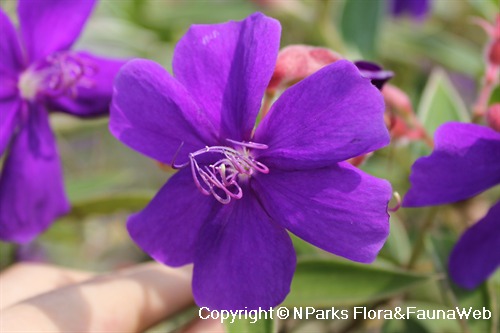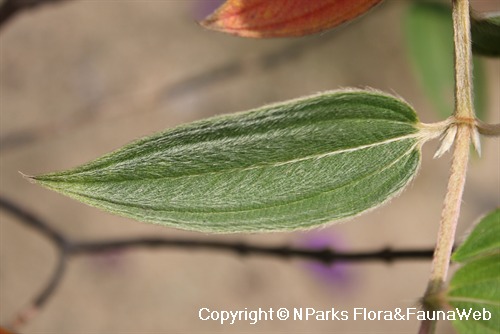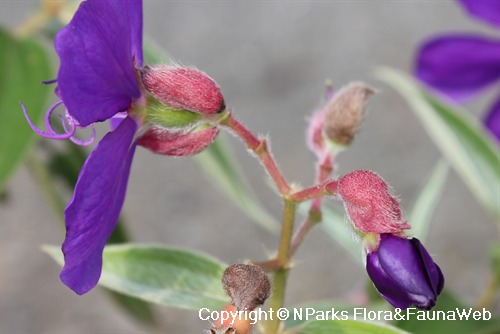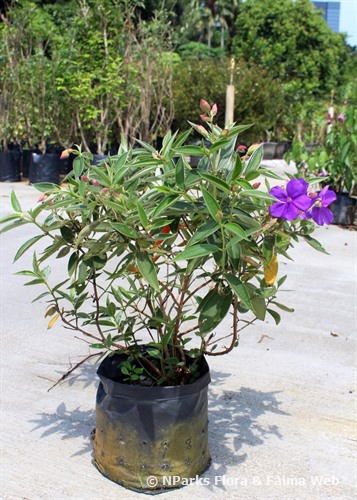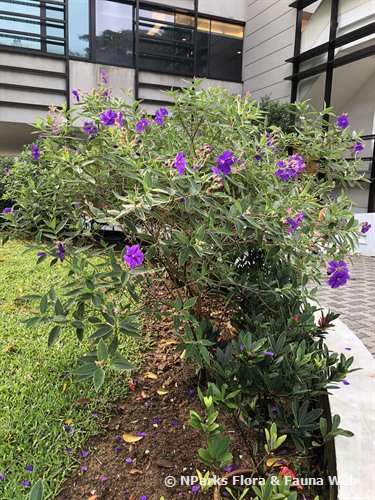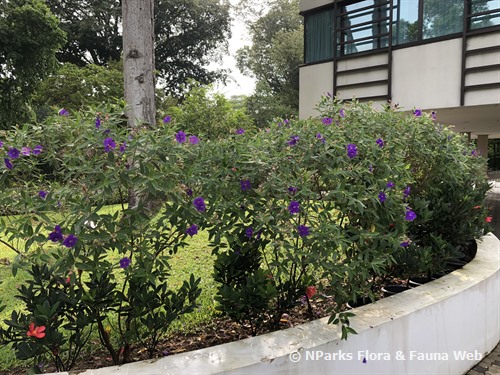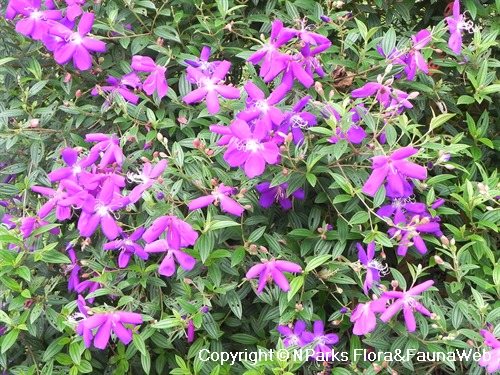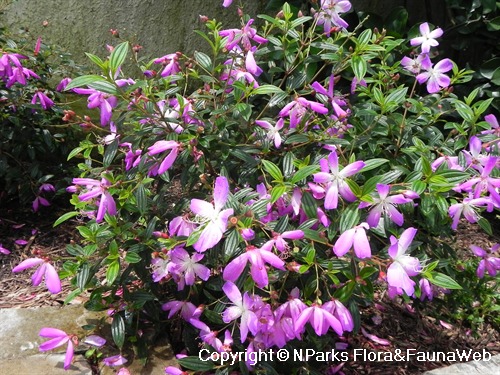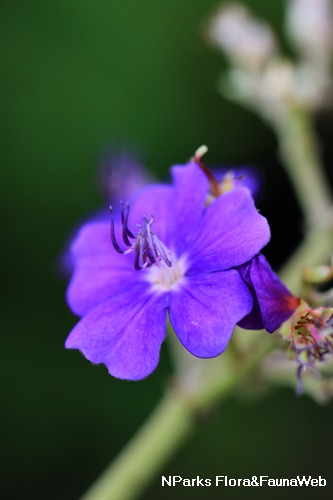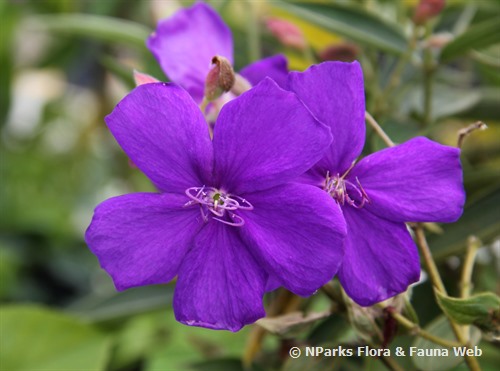
Back
Tibouchina urvilleana (DC) Cogn.
| Family Name: | Melastomataceae |
| Synonyms: | Appendicularia grandiflora, Appendicularia splendens, Pleroma urvilleana, Lisiandra |
| Common Name: | Princess Flower, Glory Bush, Purple Glory Tree, Lasiandra, Pleroma, Brazilian Sendudok |
Name
Classifications and Characteristics
| Plant Division | Angiosperms (Flowering Seed Plants) (Dicotyledon) |
|---|---|
| Plant Growth Form | Shrub |
| Lifespan (in Singapore) | Perennial |
| Mode of Nutrition | Autotrophic |
| Plant Shape | Rounded |
| Maximum Height | 4 m |
| Maximum Plant Spread / Crown Width | 2.5 m |
Biogeography
| Native Distribution | Southern & Eastern Brazil |
|---|---|
| Preferred Climate Zone | Tropical |
Description and Ethnobotany
| Growth Form | It is usually an evergreen woody shrub that forms sprawling clumps, but sometimes also a small tree with a rounded crown. |
|---|---|
| Foliage | Leaves are greyish green and are softly hairy. Oppositely arranged along the stems, leaves are narrowly ovate with entire leaf margin (5 - 10 cm long, 2.5 - 3.8 cm wide). They have pinnate venation with 3 - 5 midribs. |
| Stems | Young stems are 4-sided and covered in short hairs. |
| Flowers | Large, bright purple flowers with 5 obovate petals (7.5 cm wide). The stamens are held horizontally and curve upwards near the tip. Flowers last only about a day. The inflorescence is a terminal cluster. |
| Fruit | Hypanthium develops into the fruit. It is reddish and shaped like a U-shaped vase (1.5 cm long, 1 cm wide). |
| Habitat | It is considered an invasive species in Hawaii where it is found in damp areas, such as forests and roadsides. |
| Cultivation | This fast-growing species is suitable for beginners, requiring little maintenance. It grows best in fertile, moist, but well-draining soil that is slightly acidic. Space individuals 2.4 - 3 m apart. Protect this species from wind and direct afternoon sun during hot weather. Feed plants with a phosphorus rich fertilizer after blooming. This species has a sprawling growth habit, so pinch branch tips to promote branching and gently prune after flowering to form a bushy, round shape. It can also be planted in a large container and placed on a sunny patio. This species is usually resistant to pests and diseases, but sometimes attacked by nematodes, scale insects and geranium budworm. Avoid overwatering to prevent plants from developing mushroom root rot. |
| Etymology | The genus "Tibouchina" is derived from the name of plants in a native language of Guiana. |
Landscaping Features
| Landscaping | This species is often used as an ornamental shrub in subtropical and tropical climates. It may be used as a specimen plant, as the large, bright purple flowers are sure to attract interest. The greyish green, softly hairy leaves provide a contrast in colour and texture when placed next to plants with smooth, green foliage. |
|---|---|
| Desirable Plant Features | Ornamental Flowers |
| Landscape Uses | General, Flowerbed / Border, Focal Plant, Container Planting |
| Usage Hazard - Cons | Invasive / Potentially Invasive |
Plant Care and Propagation
| Light Preference | Full Sun |
|---|---|
| Water Preference | Lots of Water |
| Plant Growth Rate | Fast |
| Rootzone Tolerance | Fertile Loamy Soils, Well-Drained Soils, Acidic (low pH) Soils, Easy to Grow, Disease / Pest Resistant |
| Maintenance Requirements | Moderate |
| Pruning | Branch tips needs to be pinched to promote more branching and gently pruned after flowering to form a bushy, round shape. |
| Fertilizing | Feed with phosphorus fertilizer after blooming. |
| Potential Problems | Avoid overwatering to prevent from root rot. |
| Propagation Method | Seed, Stem Cutting, Division |
| Propagation Method Remarks | Softwood cuttings will root easily when placed in moist soil. |
| Planting Distance | 2 to 3 |
Foliar
| Foliage Retention | Evergreen |
|---|---|
| Mature Foliage Colour(s) | Green |
| Mature Foliage Texture(s) | Hairy / Hirsute |
| Prominent Young Flush Colour(s) | Green |
| Young Flush Texture(s) | Hairy / Hirsute |
| Foliar Type | Simple / Unifoliate |
| Foliar Arrangement Along Stem | Opposite |
| Foliar Shape(s) | Non-Palm Foliage (Ovate, Lanceolate, Elliptical) |
| Foliar Venation | Pinnate / Net |
| Foliar Margin | Entire |
| Foliar Apex - Tip | Acute |
| Foliar Base | Rounded / Obtuse |
| Typical Foliar Area | Microphyll ( 2.25cm2 - 20.25 cm2 ), Notophyll ( 20.25cm2 - 45 cm2 ) |
| Leaf Area Index (LAI) for Green Plot Ratio | 4.5 (Shrub & Groundcover - Dicot) |
Non - Foliar and Storage
| Stem Type & Modification | Woody |
|---|---|
| Root Type | Underground (Tap Root) |
Floral (Angiosperm)
| Flower & Plant Sexuality | Bisexual Flowers |
| Flower Colour(s) | Purple |
|---|---|
| Flower Texture(s) | Smooth |
| Flower Grouping | Cluster / Inflorescence |
| Flower Symmetry | Radial |
| Individual Flower Shape | Stellate / Star-shaped |
| Flower Size - Remarks | 7.5 cm wide |
| Flowering Period | Free-Flowering |
| Flower Lifespan on Plant | 1 Day |
| Flowering Habit | Polycarpic |
Fruit, Seed and Spore
| Mature Fruit Colour(s) | Red |
|---|
Image Repository
Others
| Master ID | 1220 |
|---|---|
| Species ID | 2513 |
| Flora Disclaimer | The information in this website has been compiled from reliable sources, such as reference works on medicinal plants. It is not a substitute for medical advice or treatment and NParks does not purport to provide any medical advice. Readers should always consult his/her physician before using or consuming a plant for medicinal purposes. |

